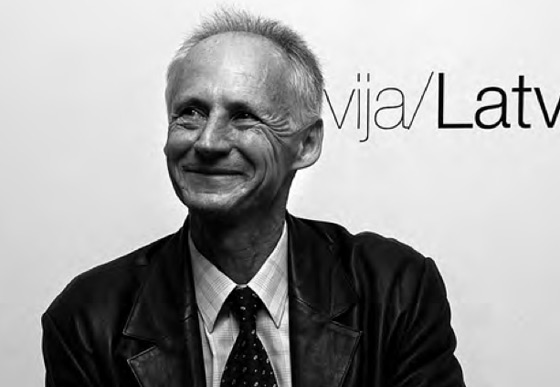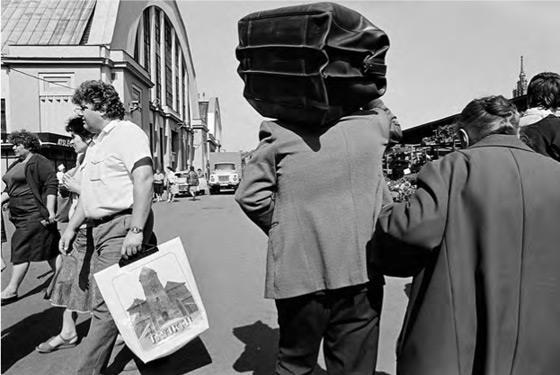|
|
| Captured by Photography. A Note Katrīna Teivāne-Korpa, Culture Theorist Gvido Kajons. Theme 011 03.10.–03.11.2013. Latvian Museum of Photography | |
| Writing exhibition reviews, especially with regard to retrospectives, is an intriguing process. Some sort of common denominator must be found between one‘s own subjective point of view and the author‘s intentions, and if in addition the distance of time is involved, the task becomes even more complicated. On the one hand, this time lapse offers you already known landmarks to assist evaluation and understanding, but, on the other hand, it introduces a confusing uncertainty into one‘s own vision. The question can arise: to what extent should one turn to the past, to the time when the work was cre- ated, and how faithful should one remain to the impulse that springs up now - at this very moment as I am viewing the work? This year the Latvian Museum of Photography marked its 20th anniversary. The event was duly celebrated over the whole year, offering on a regular basis, for the attention of viewers, pearls from Latvian photographic art collections, with the main focus on works created during the 2nd half of the 20th century. One of these ‚golden treasury’ exhibitions was Gvido Kajons‘ Theme 011, displayed on both floors of the museum. An iconic series of lasting significance in the history of Latvian art photography. I went along to view it in happy anticipation, because Gvido Kajons, alongside Andrejs Grants, Valts Kleins and Inta Ruka, is one of those Latvian photographers whose creative works I came to know at a time when photography was an exciting daily hobby, and the skills of developing a black-and- white film raised my self-esteem to dizzying heights. In the 1990s, Kajons’ works were both a model for compositional studies and a source of inspiration; you just enjoyed looking at them. Many a summer has passed since then, and the recognition of this, while visiting the exhibition, turned out to be stronger than the nostalgic pleasure brought about by the reunion... Unable to shake off the feeling stirred up by my visit to the exhibition, I opened up the book “Photographic Art of Latvia: History and the Present Day” at the page showing a Gvido Kajons’ work from 1979, The Vidzeme Seaside(1) (although no-one these days associates him with a photograph like that). The image, found in the landscape section, is a good example of photomontage and features on the foreground a boat, “opened up” from the inside, the floor of which is covered in water mirroring the skies. As a contrast, the prow of the boat is pointing towards a rough sea which, crashing wildly against the shoreline boulders, leaves hanging in the air petrified splashes of water. The abstract pattern of waves thrown against the skies is the most compelling element in the composition of the image. It invites you to explore the lines frozen in the photograph and the paths of the scattered drops, but the movement perfectly brought to a halt stirs up an unexpected unease. I had never thought that I’d resort to speaking of death in the context of a photographic image, and yet – with each moment the association with ‘monument’ grew increasingly pressing. | |
 Gvido Kajons. 2013 Photo: Astrīda Meirāne Publicity photo | |
| But after all, Theme 011 is a monument in itself. Firstly, of course, the photographs in this series store memories about the way we were and the urban environment during the final years of then Soviet Latvia (most of the photographs were taken in the 1980s). The images are like a reference to the time when the tra- dition of contemporary documentary photography began to take shape over here, bringing to the fore a more private, subjective view of everyday activities, the environment and people, without being overwhelmed by excess dramatism. Besides, Gvido Kajons has al- ways stood out with the high technical quality of his works, and the series is also outstanding testimony to that. (Not without reason Laima Slava, in characterising the photographer’s work, used the term “a perfectionist of professional photography”(2).) Unable to settle on a stable position between the uncertainty triggered by my subjective impulse in response to the exhibition and the convincing weight of cultural historical significance and refined aesthetics of Theme 011, I decided to leaf through old press materials and to read what the photographer’s contemporaries had written about his works. A brief excursion in time is always useful for establishing clarity. In a 1986 publication ‘Stonewall snowdrops, or a review on a still non-existent solo exhibition’, Valts Kleins wrote about his colleague’s works the following: “At the foundations of everything there is Gvido’s attitude towards photography and his works which, to be honest, are in discord and do not coincide with the opinion of the majority. His position might be called passive, or minimally active, if we should presume that a good photographer has obtained many medals (or at least diplomas) and has participated in count- less exhibitions abroad. Even worse. He believes that that is not at all necessary, as sometimes there is nothing hiding under the dazzling exterior – it is but an empty confectionery wrapper (..) Gvido does not even claim to make a categorical judgement or to condemn, but in his essence and his works detaches himself from the noisy main road. This means a more intimate, calm observation and more profound contemplation. The photograph is being set a totally different task with a different result to be delivered.” Turning to the execu- tion of the photographs, Kleins remarks: “Gvido, with a documentary photographer’s frontal approach to the object, as if tears down the last bastions of the unfathomable – romanticism, mysteriousness, retro fashion. (..) The image brings closer, concentrates together time periods into one series of works, pulling out apparent details from the context of the everyday.”(3) To the above may be added what Andrejs Grants wrote in 1987: “The vision of the world offered by Gvido Kajons is coolly analytical. Nevertheless it attracts us and makes us look deeper into the inter- nal and external world, both the photographer’s and our own.”(4) In the 12 February, 1988, issue of Literatūra un Māksla, jour- nalist Ērika Šmeļkova writes about Kajons’ exhibition at the Architects’ House, where several photographs from the Theme 011 series were exhibited for the first time: “The paradox of Gvido’s photos is that the things photographed are of the most mundane origin. Exactly the things that we see, without any particular effort, almost every day, walking along the street or through a tram window, but in a photograph we look at the same things as though a phantom had materialised, or they were snapshots from another planet. (..) Perhaps this is because, if compared to the works of other authors where the focus is on, for instance, a naked breast, a glance or something of the kind, in Gvido’s photographs there are no subsidiary elements, everything is the main focus. We scrutinise our recent past, for example, the October Revolution anniversary procession of 1987, with the same interest as photographs from the beginning of the 20th century in which one takes pleasure of seeing not only a historic personality or beautiful things, but also takes an interest in a shoelace knot.”(5) The texts cited, in my opinion, clearly indicate the relevance of Gvido Kajons’ works at the time when they were created, and why it is still interesting to view them, yet simultaneously they also reveal the cause of my divided feelings. “Technical sterility”, the detailed sharpness, paradoxically both attract and repel. Līga Lindenbauma has aptly pointed out in an article titled ‘Following the footsteps of Group A’ that within the framework of Theme 011, Gvido Kajons had turned to “a graphical depiction of the urban landscape”(6) | |
 Gvido Kajons. At the Market. Portrait of a Back Publicity photo Courtesy of the artist and Latvian Museum of Photography | |
| Graphic explicitness in photography, of course, is neither new nor surprising and besides, one should take into account Kajons’ interest in all kinds of signage, textures, the geometrical interplay of objects; however, the pronounced sharpness compressing the dimensions of space in these photographs seems almost menacing. Time brought to a standstill has been completely wrenched out from the flow, which inevitably makes one think of its finality, and those are unpleasant feelings. Still, from the other side, it should be admitted that the heightened aestheticism allows one to view it also as a stage setting, stage property, which is quite well-suited to the era fixed in the photo and which we now view from a safe distance. As if it had merely been scenery, and was removed with the beginning of a new of act of the “performance”. The photographer’s enthusiasm for capturing signage and plays of words in the public space, already mentioned, and the seeking of witty compositional solutions makes the reference to stage decor even more appropriate. Exhibitions by Gvido Kajons are a rare event, and Theme 011 is a suitable series for recalling the prominent author’s achievements, or for getting acquainted with his work, if one has not yet managed to do so. Likewise it is noteworthy that this event of almost anniversary celebration scale was accompanied by the publication of a catalogue which features not only Theme 011 photographs, but also portraits taken in the 1980s and 90s. A publication such as this offers the opportunity of thinking about and discussing Kajons’ works also after a visit to the exhibition, and that, as I found out, is a desirable process for releasing from petrifaction the moments so masterfully captured. Translation into English: Sarmīte Lietuviete (1) Latvijas fotomāksla: Vēsture un mūsdienas. Compiled by P. Zeile. Rīga: Liesma, 1985, p. 234. (2) Slava L. Noslēpuma sajūtas uzturētājs. Grām.: Andrejs Grants. Fotogrāfijas. Rīga: Neputns, 2002, p. 2. (3) Kleins V. Mūru sniegpulksteņi jeb recenzija par vēl neesošu personālizstādi. Liesma, 1986, No. 7, pp.16–17 (4) Grants A. Gvido Kajons. Avots, 1987, No. 1, p. 53. (5) Šmeļkova E. Gvido Kajona skatījumā. Literatūra un Māksla, 1988, Feb. 12, p. 10. (6) Lindenbauma L. Pa “A” grupas pēdām. Foto Kvartāls, 2006, No. 1, p. 71. | |
| go back | |







